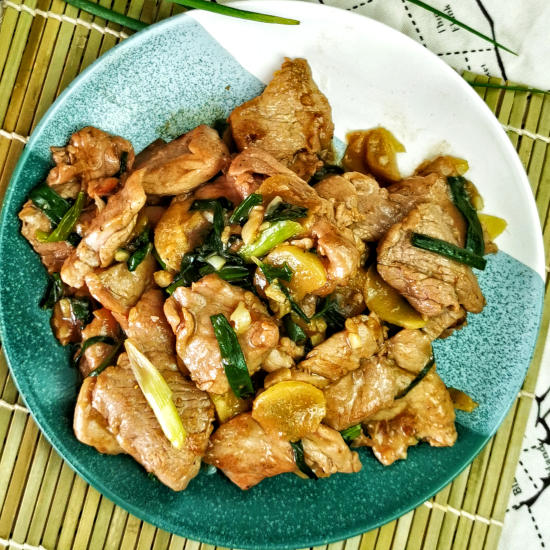Pork stir-fry with ginger and spring onion is one dish that is regularly included in my dinner rotation, not only because it is tasty but also one of my quick and easy dinner recipes.
The pork recipe is an extension of the more popular variation, beef stir-fry with ginger and spring onion. The preparation method is pretty similar, but since pork is the staple for most Chinese, it has become popular on its own in many Chinese households. Since my mother does not eat beef, she has cooked this pork dish frequently since I was young.
Here are the steps to stir-fry pork with ginger and spring onion.
Note: This post may contain affiliate links. Please read my privacy policy for more info. I may receive commissions for purchases made through links in this post. As an Amazon Associate, I earn from qualifying purchases.

1. Marinate the pork
Pork tenderloin or pork loin is my choice because it is tender and quick to cook when thinly sliced. Pork shoulder is another cut of pork suitable, especially if you like it fattier.
- Cut the pork tenderloin into two-inch length blocks, then slice it thinly by following the grain into thin slices. Cutting pork loin is different from beef, as slicing it across the grain will cause the pork to break into small pieces during stir-frying.
- Place the thin pork strips in a large bowl.
- Add the light soy sauce, cornstarch, salt, and some oil and mix well. Set aside to marinate for at least fifteen minutes.
2. Prepare the aromatic ingredients
- Cut the spring onions into one-inch sections.
- Slice the ginger thinly with a sharp knife. I pick young ginger root as it is less fibery than the old one.
- Bash the garlic cloves and then coarsely chop. There is no need to mince it as minced garlic can burn quickly.
Note: Cutting the ginger thinly is a trick I learned from my wife. Thin slices of ginger will turn brown quickly while sauteing, turning it into a slightly crispy and becoming very aromatic. Also, since it is thin, it will absorb the gravy quickly during cooking and become exceptionally tasty.
3. Stir-fry the pork tenderloin
A well-seasoned cast-iron wok is ideal for any stir-frying wok. Alternatively, a large skillet or a large frying pan is equally good, especially if it is coated with non-stick material.
- Add some peanut oil to the wok and bring it to medium heat. Other vegetable oil with high smoke points and neutral flavors are also suitable. Olive oil is unsuitable if you want to get the authentic Chinese taste.
- Then, saute the coarsely chopped garlic, followed by the thinly sliced ginger and spring onions. Keep stir-frying for about a minute or until aromatic, then remove from the wok. Leave the remaining oil in the wok.
- Add more oil to the wok if necessary, then heat up and pour in the marinated sliced pork, following with quick flips and stirs to avoid them from sticking since the pork is marinated with cornstarch.
- Continue stir-frying the pork until cooked and both sides start to turn light brown.
- Return the sauteed garlic, ginger, and spring onion to the wok.

4. Seasoning for the pork
- Measure all the seasoning ingredients for the sauce in a small bowl, or you can add them directly into the wok if you are confident with the amount and types of ingredients you need. The seasonings are light soy sauce, oyster sauce, and ground black pepper. The amount is just enough to add some extra flavor, and we are using marinated pork.
- Lastly, add a teaspoon of sesame oil and some Chinese rice wine.
- Now stir-fry over medium-high heat briefly, then add the cornstarch slurry to thicken the sauce.
- Dish out and serve with cooked rice or noodles.
Note:
Since the time required to saute the aromatic and stir-fry pork is different, it is better to cook them separately and then combine them later. This way makes it easier to control the pork’s timing and doneness without worrying that the aromatic will overburn if stir-frying together from the beginning.
This simple recipe is best for busy weeknights. All you need is to marinate the pork in advance, and you can bring it onto the dining table within fifteen minutes.
Variation of stir-fried pork with ginger
Here are some ideas to make some variations to the basic stir-fry pork dish:
- As an alternative, you can explore substituting the light soy sauce with Vietnamese fish sauce for a change. You can also add a small amount of hoisin sauce and rice vinegar. These items are commonly used by the Chinese and are available in grocery stores or Asian markets.
- Try to stir-fry some red peppers, snap peas, snow peas, and onion chunks with the pork for a change.
- You can use the same recipe for cooking boneless pork chops.
Related recipes
If you like this ginger pork stir-fry recipe, here are some other related recipes on this blog worth trying:
Sweet and sour pork is a traditional Chinese cuisine with a universal appeal. It is easy to prepare and kid-friendly, perfect for any busy home cook.
Wuxi pork ribs are so tender that the meat is almost melting off from the bone!
Braised pork belly is a well-known pork dish prepared with a combination of ginger, garlic, soy sauce, and a myriad of aromatic spices and cook over an extended period.
Pork stir-fry with ginger- quick and easy Cantonese recipe

Pork stir-fry with ginger and spring onion is one dish that is regularly included in my dinner rotation, not only because it is tasty but also one of my quick and easy dinner recipes.
The pork recipe is an extension of the more popular variation, beef stir-fry with ginger and spring onion.
Ingredients
Ingredients A
- 370g pork tenderloin, thinly sliced follow the grain
- 1 tbsp light soy sauce
- 1 tsp cornstarch
- 1/2 tsp salt
- 1 tbsp peanut oil
Ingredients B
- 40g spring onions, cut to 1-inch sections
- 50g ginger, sliced thinly
- 3 cloves garlic, coarsely chopped
Ingredients C
- 2 tsp light soy sauce
- 1 tbsp oyster sauce
- 1 tbsp Chinese rice wine
- 1/2 tsp ground pepper
- 2 tsp cornstarch (mix with 3 tbsp of water)
- 1 tsp sesame oil
Instructions
- Slice the pork thinly by following the grain into thin slices. Marinate with ingredients A for at least fifteen minutes.
- Cut the spring onions into one-inch sections.
- Slice the ginger thinly with a sharp knife.
- Bash the garlic cloves and then coarsely chop.
- Add some peanut oil to the wok and bring it to medium heat.
- Then, saute the coarsely chopped garlic, followed by the thinly sliced ginger and spring onions until aromatic, then remove from the wok.
- Add more oil to the wok and pour in the marinated sliced pork, followed by quick flips and stirs to avoid them from sticking. Continue stir-frying the pork until cooked and both sides start to turn light brown.
- Return the sauteed garlic, ginger, and spring onion to the wok.
- Season with ingredients C except for the cornstarch. Mix well.
- Add the cornstarch slurry to thicken the sauce.
- Dish out and serve with cooked rice or noodles.
Recommended Products
As an Amazon Associate and member of other affiliate programs, I earn from qualifying purchases.
-
 Stainless Steel Mixing Bowls by Finedine (Set of 6) Polished Mirror Finish Nesting Bowl, ¾ - 1.5-3 - 4-5 - 8 Quart - Cooking Supplies
Stainless Steel Mixing Bowls by Finedine (Set of 6) Polished Mirror Finish Nesting Bowl, ¾ - 1.5-3 - 4-5 - 8 Quart - Cooking Supplies -
 Rice Cooking Wine (Red) - 750ml (Pack of 1) by Shaohsing
Rice Cooking Wine (Red) - 750ml (Pack of 1) by Shaohsing -
 Lee Kum Kee Premium Light Soy Sauce - 150ml (5.27 fl oz)
Lee Kum Kee Premium Light Soy Sauce - 150ml (5.27 fl oz) -
 Lodge 14 Inch Cast Iron Wok. Pre-Seasoned Wok with Flattened Bottom for Asian Stir Fry and Sautees
Lodge 14 Inch Cast Iron Wok. Pre-Seasoned Wok with Flattened Bottom for Asian Stir Fry and Sautees
Nutrition Information:
Yield:
3Serving Size:
1Amount Per Serving: Calories: 282Total Fat: 11gSaturated Fat: 3gTrans Fat: 0gUnsaturated Fat: 7gCholesterol: 90mgSodium: 1232mgCarbohydrates: 9gFiber: 1gSugar: 1gProtein: 34g
This data was provided and calculated by Nutritionix on 3/23/2022

Elisha
Wednesday 28th of June 2023
Hello, this recipe is fabulous. Is it ok to add some red pepper flakes for heat and maybe another vegetable.
KP Kwan
Sunday 2nd of July 2023
Sure. Adding chili flakes is a great way to give your food a spicy kick.
Wen
Friday 24th of February 2023
Absolutely delicious!! It is going to part of my dinner rotation.
KP Kwan
Thursday 31st of March 2022
Hi, this is KP Kwan. I am happy to see you in this comment area, as you have read through my recipe. I am glad to reply to any questions and comments as soon as possible.
David Bridges
Friday 1st of April 2022
@KP Kwan, thanks for the tip about slicing tenderloin with the grain instead of against it, as I do with beef. I shall remember to do that in future.